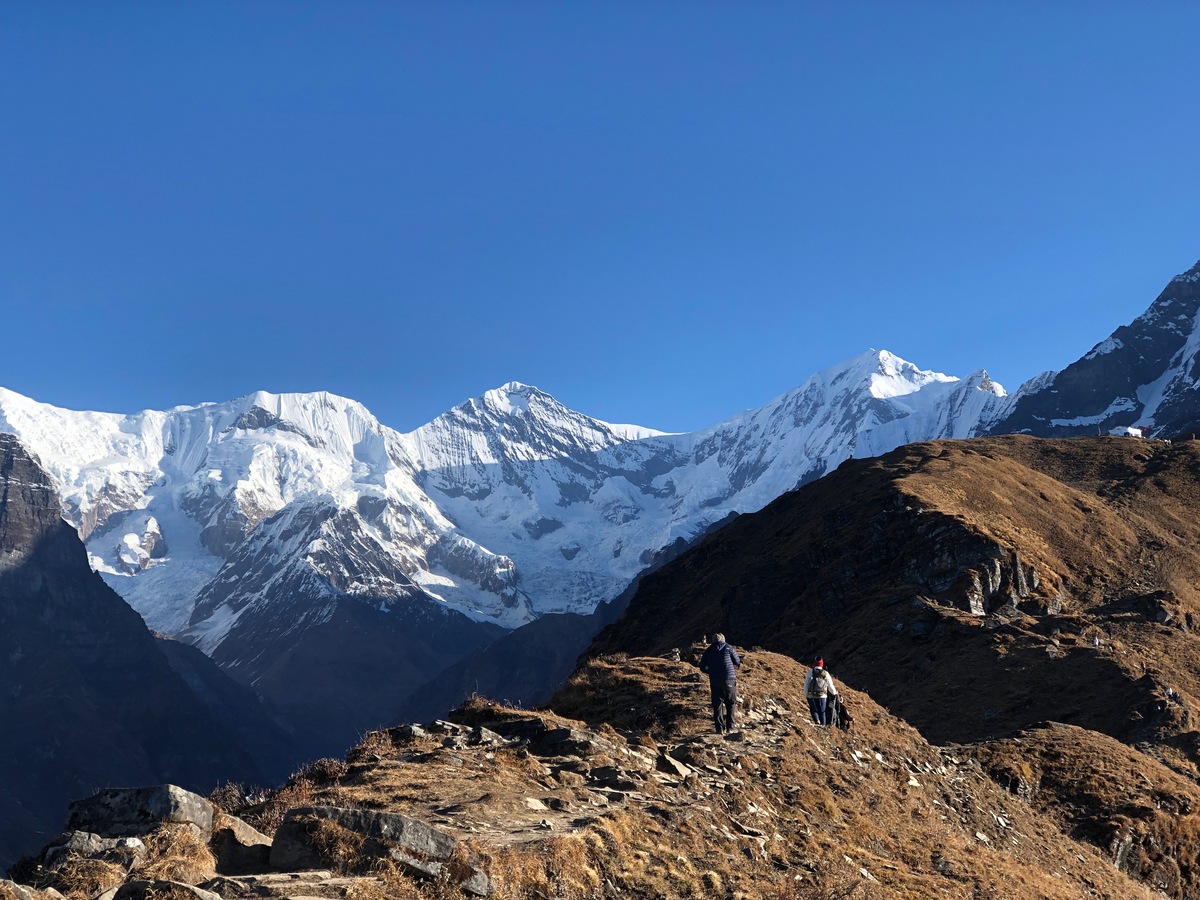Trek Overview
The Mardi Himal Trek, nestled in the Annapurna Region, is a relatively famous and captivating trekking destination. It offers a unique escape from crowded trails, leading you through pristine rhododendron forests and alpine terrain. This trek provides unparalleled, close-up views of towering peaks like Mardi Himal, the majestic Machhapuchhre (Fishtail), and parts of the Annapurna range, offering a tranquil and authentic Himalayan and cultural experience.
The Mardi Himal Trek is typically a moderate 5-7 day adventure. Starting from Pokhara, the trail ascends gradually, leading to charming teahouses. You will enjoy traversing dense forests, reaching High Camp for breathtaking sunrise views, and finally, the exhilarating walk to Mardi Himal Base Camp at around 4,500 meters. This trek is renowned for its panoramic vistas, showcasing the raw beauty of the Himalayas with every step.
The Mardi Himal Trek is perfect for those seeking a shorter, less strenuous, yet incredibly rewarding Himalayan journey. It promises unforgettable close-up mountain views, a peaceful environment, and a true sense of wilderness. It's an ideal choice for guests desiring a unique and memorable trekking experience in Nepal.
Highlights of the Mardi Himal trek
- You get incredibly close and clear views of famous peaks like Machhapuchhre (Fishtail), Mardi Himal, and the vast Annapurna range.
- Unlike some busier treks, Mardi Himal offers a peaceful journey through pristine nature, perfect for a city escape.
- The trails are paved in enchanting rhododendron and oak forests, especially vibrant during spring blooms, making for relaxing walks during the trek.
- Witness an unforgettable sunrise from High Camp, as the golden light illuminates the majestic Annapurna range, Mardi Himal, and sacred Himalayan peaks like Machhapuchhre (Fishtail) and many other peaks above 6000 meters.
- You stay in simple, cozy tea houses along the way, connecting with local culture and enjoying warm Nepalese hospitality.
How long is the Mardi Himal trek?
The Mardi Himal trek itself involves a walking journey that typically lasts between 5 to 7 days. This timeframe is ideal for most trekkers to comfortably ascend through the stunning landscapes, reach the incredible viewpoints, and then safely descend back down the mountain trails.
For the entire adventure, from when you arrive in Nepal until your departure, you should plan for a trip that usually spans 7 to 10 days. This extended duration includes time for your international travel to Kathmandu, the scenic domestic journey to Pokhara (which is the starting point for the trek), and often an extra day for rest or exploring these cities.
So, while the actual time spent trekking in the mountains is quite manageable, the overall trip allows for all the necessary travel and preparation, making it a complete and memorable Himalayan experience.
Is the Mardi Himal Trek difficult?
The Mardi Himal Trek is generally considered moderately difficult, making it suitable for most people with a reasonable level of fitness. You'll be walking for about 5-7 hours daily, descending and ascending through dense forests and sometimes rocky, steep paths, especially nearing High Camp and Mardi Himal Base Camp (around 4,500m). While the altitude can be a challenge, overnight stays are typically at lower elevations (like High Camp at ~3,600m), which helps with acclimatization. It's not a highly technical trek, meaning you won't need special climbing skills.
However, some prior hiking experience and preparation, like regular walking or light exercise, will make it more enjoyable. Overall, it's a rewarding trek that offers stunning Himalayan views without being as demanding as some of the longer, higher-altitude expeditions.
![]high camp mardi himal trek](https://media.app.viewnepaltreks.com/uploads/media/Mardi%20Himal%20trek/IMG_4715.jpg)
How much does the Mardi Himal trek cost?
The cost of the Mardi Himal trek can vary significantly, typically ranging from around $300 to $900+ per person. This price depends on factors like the trek's duration, 4-7 days, whether you opt for a guided package or trek independently, and your group size. Larger groups often benefit from lower per-person rates.
Most package tours cover essential expenses such as trekking permits (ACAP and TIMS), the services of a professional guide and porter, teahouse accommodation along the trail, and basic meals during the trek. Transportation to and from the trailhead from Pokhara is also usually included in these packages.
However, be aware that certain costs are generally excluded. These typically involve international flights, your Nepal visa fee, personal travel insurance, and expenses like snacks, hot showers, phone charging, alcoholic beverages, and tips for your trekking staff. A general estimate for a 5-day guided trek often falls between $400-$600 per person.
Which is better, Mardi Himal or Poon Hill Trek?
If you are choosing between Mardi Himal and Poon Hill Trek, you should first think about what you want.
If you want an easy and short trek, you will enjoy Poon Hill. You can see a famous sunrise over the Annapurna and Dhaulagiri mountains, walking through beautiful villages, rhododendron forests, and well-made trails. If you are new to trekking or have less time, this trek is perfect. You can finish it in 3 to 5 days.
If you want more adventure and fewer crowds, choose the Mardi Himal trek. You can walk on peaceful, well-maintained scenic trails. You will see stunning close-up views of Mardi Himal Machhapuchhre (Fishtail), Annapurna South, and more. This trek is harder than Poon Hill but gives you a special mountain experience. You will need around 5 to 7 days for Mardi Himal.
So, if you want an easy trek with sunrise views and culture, you should choose Poon Hill. But if you want quiet trails and close mountain views, Mardi Himal is better for you. Both treks will give you unforgettable memories.










.webp&w=1200&q=75&dpl=dpl_7cgNcgNPMwvzLsbEA8JdiiBMtHYT)
